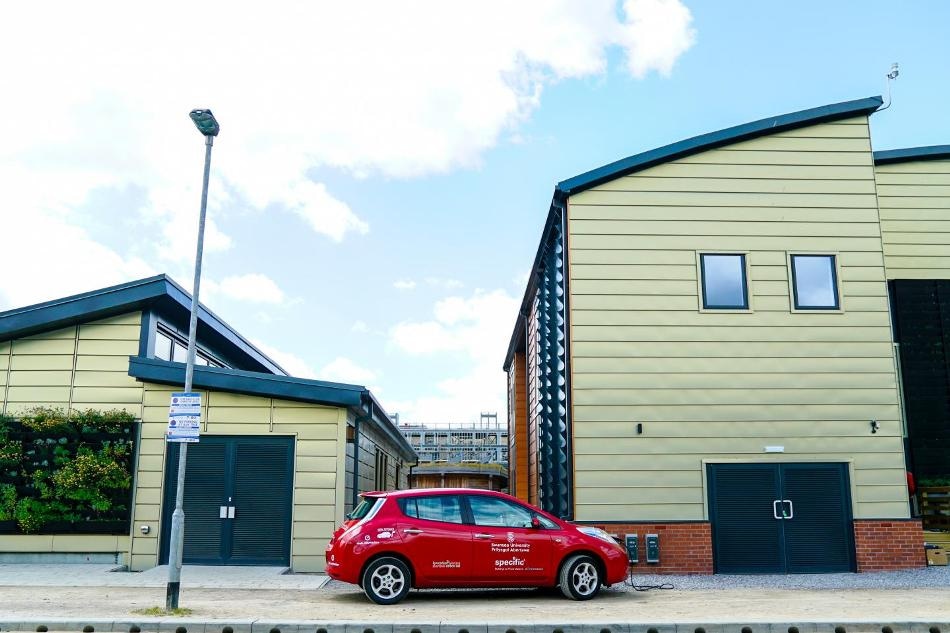Jun 21 2018
The first energy-positive classroom in the UK, designed with Swansea University’s research expertise, produced over one and a half times the energy it consumed. This is according to the data collected from its first year of operation, say researchers.
 These are the UK's first energy-positive buildings, which generate more energy than they consume. Left - Active Classroom, which generated 1.5 times the energy it used, during its first year. Right - Active Office, just launched as the next phase of research. (Image credit: SPECIFIC/Swansea University)
These are the UK's first energy-positive buildings, which generate more energy than they consume. Left - Active Classroom, which generated 1.5 times the energy it used, during its first year. Right - Active Office, just launched as the next phase of research. (Image credit: SPECIFIC/Swansea University)
These findings were reported simultaneously as the researchers set off the next phase of their study, which involved collecting proof and data on an office building that was built using similar techniques.
At present, buildings are responsible for about 40% of UK energy consumption. This innovative building, called the Active Office, shows how a new generation of low-carbon offices can be designed and such buildings are capable of producing their own supply of clean energy.
SPECIFIC, a UK Innovation and Knowledge Center headed by Swansea University, designed the building.
Professor Dave Worsley, Research Director for SPECIFIC as well as Swansea University College of Engineering, clarified how SPECIFIC’s work involves a two-way connection between research and real-world application:
"SPECIFIC's research focuses on developing solar technologies and the processing techniques that take them from the lab to full-scale buildings.
With our building demonstration programme we are testing and proving the 'buildings as power stations' concept in real buildings, which are used every day. The data obtained from these buildings is then fed back into our fundamental research into solar energy technologies and used to accelerate and steer their development."
Several innovative technologies are used by the Active Office that will allow it to produce, store, and discharge solar energy in a single integrated system, including:
- A Photovoltaic Thermal system located on the south facing wall can generate heat as well as electricity from the sun in a single system
- A curved roof with built-in solar cells shows the versatile nature of the laminated photovoltaic panel
- Lithium-ion batteries for storing the generated electricity, and a 2,000-liter water tank for storing solar heat
It has already been demonstrated that the 'buildings as power stations' concept indeed works. The Active Classroom, the first energy-positive classroom in the UK, is right beside the Active Office. This was also constructed by SPECIFI, and the RICS Wales had recently named it the Project of the Year. The Active Classroom, in its first year of operation, produced over one and half times the energy it consumed.
The Active Classroom and the Active Office will be connected together and both would be able to share energy with one another and electric vehicles. This shows how the concept can possibly be applied to a community that is solar-powered and energy-resilient. In addition to providing office spaces and functional teaching, the Active Office and Classroom will also provide SPECIFIC and its industry partners building-scale development facilities.
The UK can considerably benefit from energy-positive buildings. According to a 2017 analysis, it would mean:
- Lower energy expenses for the consumer
- Reduced carbon emissions
- Less requirement for peak central power-producing capacity and related reduction in stress on the National Grid, resulting in better energy security
The Active Office has been made in such a way that it can be easily reproduced. It can be constructed rapidly and takes just one week to assemble, with most of the construction occurring off site. Moreover, it uses only commercially available technologies, which means they can be easily used on any new building.
Kevin Bygate, chief operating officer of SPECIFIC, said:
"Offices are enormous consumers of energy, so turning them energy-positive has the potential to slash fuel bills and dramatically reduce their carbon emissions.
Turning our buildings into power stations is a concept that works, as the Active Classroom shows. This new building will enable us to get data and evidence on how it can be applied to an office, helping us refine the design further.
The Active Office is a first, but it isn't a one-off. It is quick to build using existing supply chains, and uses only materials that are already available. This is tomorrow's office, but it can be built today."
Ian Campbell, Executive Chair of Innovate UK, said:
"It's difficult to overstate the potential of developing a building that powers itself. The concept could genuinely revolutionise not only the construction sector but completely change how we create and use energy, so the opening of the Active Office in Swansea is an exciting step forward.
Developing technologies like those demonstrated in the SPECIFIC Active Office can play a strong role in the Government's modern industrial strategy to create 'clean growth' and fulfil our mission to halve the emissions of new buildings by 2030."
Alun Cairns, Secretary of State for Wales, said:
"The Active Office is a living example of how a building can make a difference to us and our environment using innovative technologies -and equally importantly creating jobs in Wales.
"Research and innovation has a proven track record to stimulate our economy. The UK Government has been a proud supporter of the project, and last year awarded £800,000 of funding towards it via Innovate UK.
"The UK Government is ambitious for Swansea, and the Swansea Bay City Region deal is expected to deliver more than 9,000 jobs and £1.3billion of investment across the region.
"I have no doubt that I'll be back to Swansea University in the near future because of the great strides they are taking in the science and research field which are being recognised around the world."